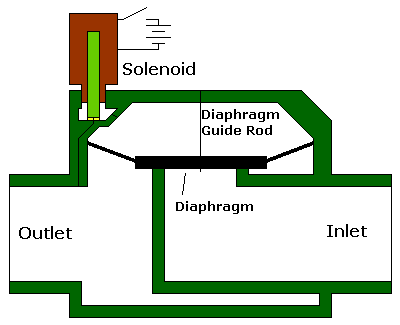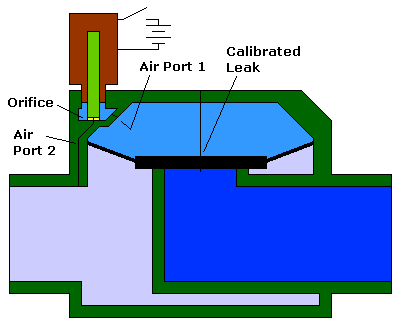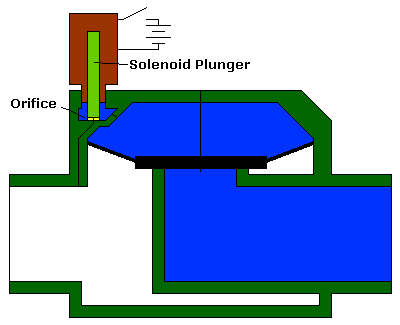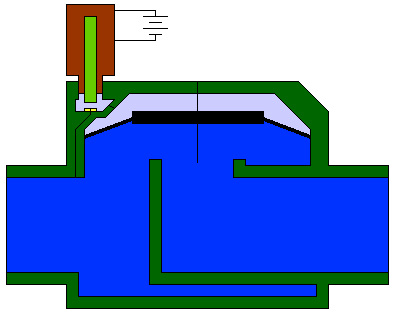So how does a sprinkler valve work? Here is a complete explanation of how a 'typical' 24V small commercial valve operates. This information was obtained from a Lawn Genie Model 54004 1" threaded ports 24V coil, a ~$20 unit. Most valves of this build covering many different manufacturers and price ranges will work very much the same. Illustrations are simplified to show how major parts function.
So, when you buy your valve, it is delivered in this state:

These pictures are shown with the spring omitted, which pushes the diaphragm down against the inlet. Fully closed the spring only exerts a few pounds of force to engage the rubber face seal of the diaphragm.
Right off the bat, you are saying: "That's a stupid design, when you hit the valve with pressure it will just push the diaphragm up, 'cause the spring is barely pushing on it, and it will always be open." Yeah, me too when I first broke a valve open. However, closer inspection shows there is actually a LEAK calibrated into the valve. Blue regions indicate relative pressures; darker blue is higher pressure. Outlet side pressure only results from the diaphragm leaking; if you fill the reservoir faster than it can bleed into the upper diaphragm chamber--only temporary.

So you are filling the reservoir the the pressure is rising on the diaphragm trying to push it UP, yet air leaks above the diaphragm so in turn pushes it DOWN at the same time. the effective area on top is actually greater so the sealing force increases with increased charge pressure. Now the valve is filled all the way and stopped leaking. If it doesn't stop leaking there is something caught between the diaphragm seal and inlet pipe end it seals against. A common occurrence for new installations is a piece of plastic sawdust stuck in there (take the valve apart....)

Alright, the system is charged, so how do we get it to fire. Actuating the solenoid lifts the plunger, which is sealing against a small orifice, either made from plastic or metal (brass). THIS IS THE LIMITING PART FOR VALVE OPERATION SPEED. The size of the orifice hole determines the force required to raise the plunger. Opening the valve lets the air above the diaphragm leak out to the low side of the system, to the point where the reservoir pressure pushing up is higher than the lowering pressure above the diaphragm. The valve is designed at the factory to leak air from the solenoid valve just a little faster than it can leak from the reservoir through the calibrated leak at the guide rod. This is to prevent water-hammer effects from ruining the valve. Since we are using compressed air, hammer effects are negligible.

"Great it opened, albeit slowly, won't it close again because air is leaking back above the diaphragm?" Yes, part of the flaw in this economical way to operate a valve. Solenoid open or not air goes back on top, so the valve can close before fully venting the reservoir. This is due to the valve's design, for water, not wanting it to leak outside anywhere. Also available are modified 1" sprinkler valves that open 10 times faster than 'standard' valves (intended then for air operation only). Check the products page.
document created 7/7/2002 7:40:59 PM;
last modified 8/29/2008 8:20:53 PM
| 
![]() New Forum
New Forum
